Finance Assignment: Valuation, Investment, and Production Analysis
VerifiedAdded on 2023/01/07
|7
|1455
|24
Homework Assignment
AI Summary
This finance assignment solution addresses three key questions. The first question involves the application of the P/E ratio and the dividend growth model for stock valuation, along with a discussion of the limitations of the dividend growth model. The second question focuses on project appraisal techniques, specifically calculating the Net Present Value (NPV) and Internal Rate of Return (IRR) of a proposed investment, and critically evaluating the use of these methods. The third question delves into production planning, identifying the limiting factor, determining the optimal production plan to maximize contribution, and calculating the breakeven point for a specific product. The solution includes detailed calculations and explanations to support the analysis, providing a comprehensive understanding of the concepts.
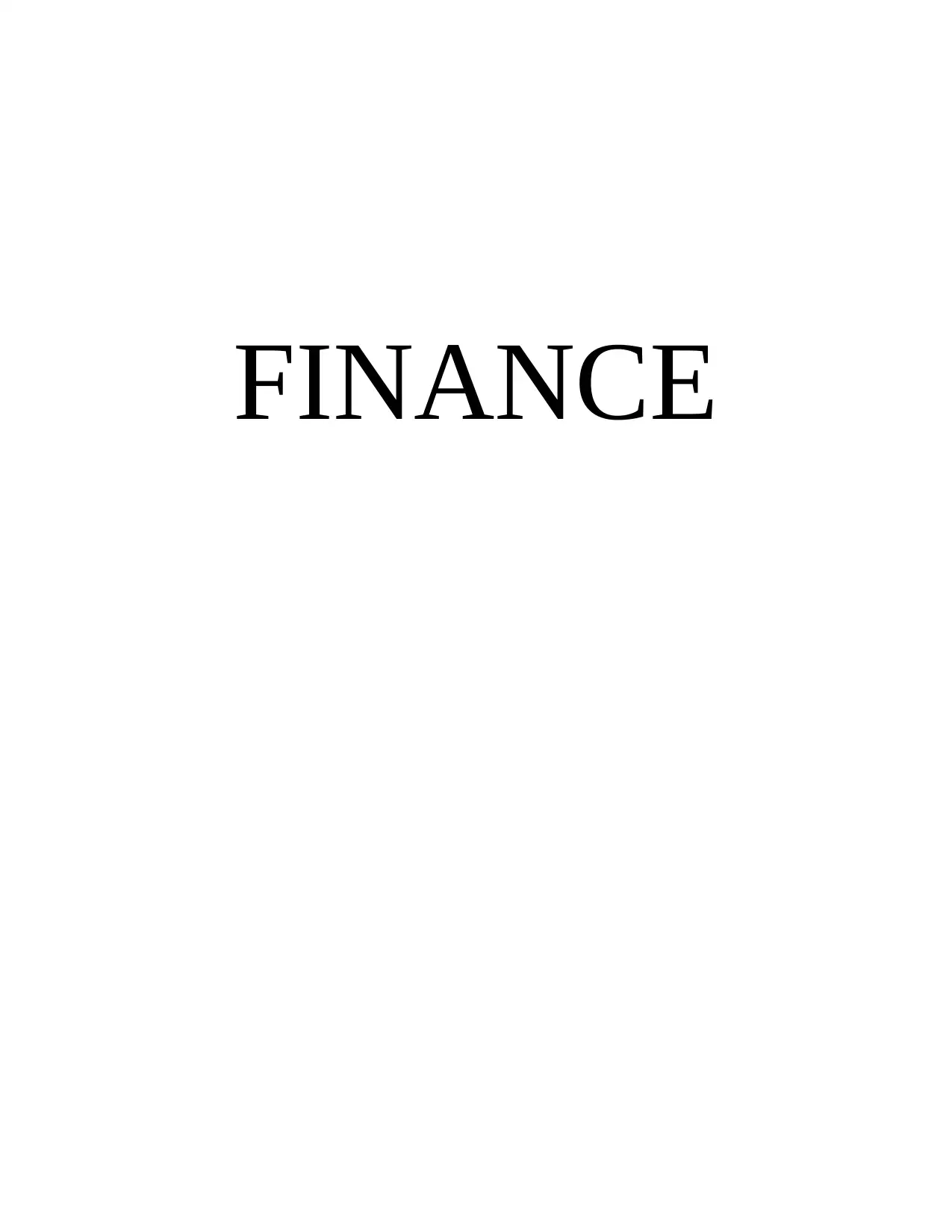
FINANCE
Paraphrase This Document
Need a fresh take? Get an instant paraphrase of this document with our AI Paraphraser
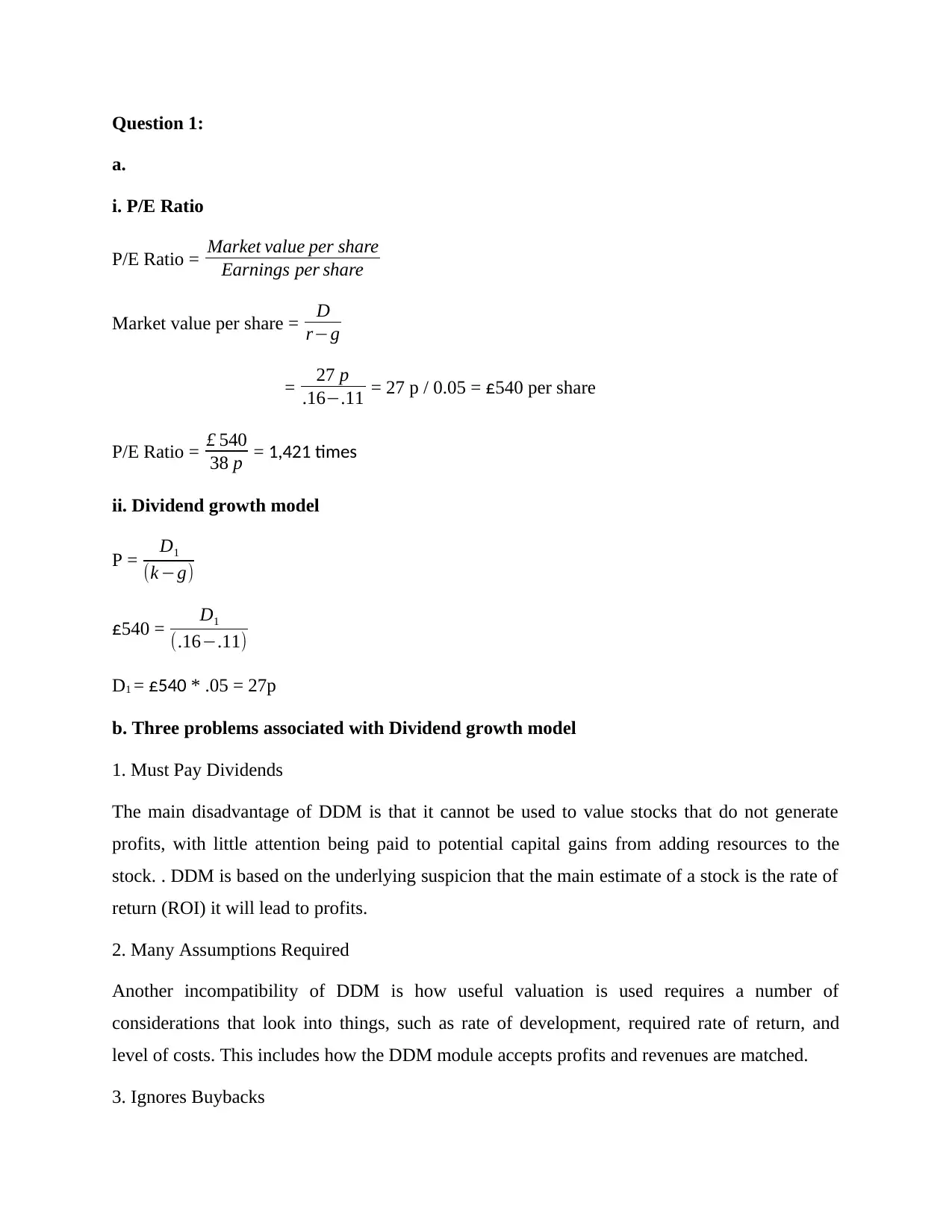
Question 1:
a.
i. P/E Ratio
P/E Ratio = Market value per share
Earnings per share
Market value per share = D
r−g
= 27 p
.16−.11 = 27 p / 0.05 = £540 per share
P/E Ratio = £ 540
38 p = 1,421 times
ii. Dividend growth model
P = D1
(k −g)
£540 = D1
(.16−.11)
D1 = £540 * .05 = 27p
b. Three problems associated with Dividend growth model
1. Must Pay Dividends
The main disadvantage of DDM is that it cannot be used to value stocks that do not generate
profits, with little attention being paid to potential capital gains from adding resources to the
stock. . DDM is based on the underlying suspicion that the main estimate of a stock is the rate of
return (ROI) it will lead to profits.
2. Many Assumptions Required
Another incompatibility of DDM is how useful valuation is used requires a number of
considerations that look into things, such as rate of development, required rate of return, and
level of costs. This includes how the DDM module accepts profits and revenues are matched.
3. Ignores Buybacks
a.
i. P/E Ratio
P/E Ratio = Market value per share
Earnings per share
Market value per share = D
r−g
= 27 p
.16−.11 = 27 p / 0.05 = £540 per share
P/E Ratio = £ 540
38 p = 1,421 times
ii. Dividend growth model
P = D1
(k −g)
£540 = D1
(.16−.11)
D1 = £540 * .05 = 27p
b. Three problems associated with Dividend growth model
1. Must Pay Dividends
The main disadvantage of DDM is that it cannot be used to value stocks that do not generate
profits, with little attention being paid to potential capital gains from adding resources to the
stock. . DDM is based on the underlying suspicion that the main estimate of a stock is the rate of
return (ROI) it will lead to profits.
2. Many Assumptions Required
Another incompatibility of DDM is how useful valuation is used requires a number of
considerations that look into things, such as rate of development, required rate of return, and
level of costs. This includes how the DDM module accepts profits and revenues are matched.
3. Ignores Buybacks

A further analysis of the DDM is that it underestimates the effects of buying shares, effects that
could have a significant impact on the shares worth returning to investors. Stock purchase
oversight explains the problem with largely traditional DDM in valuing stock values.
Meanwhile, cost structures in different countries are making it more profitable to make a
purchase versus profit.
Best Method
The P/E method is perhaps the most commonly used valuation method in the stock brokerage
industry. It is best valuation method for shares because this method shows whether the stock is
undervalued or overvalued.
Question 2:
a. Calculate net present value of the proposal
Years
0 1 2 3 4 Total
Initial investment -£2,000,000
Sales revenue
£1,800,00
0 £1,980,000 £2,178,000 £2,395,800
Less: Production cost £750,000 £787,500 £826,875 £868,219
Gross profit
£1,050,00
0 £1,192,500 £1,351,125 £1,527,581
Less: Operating
expenses
Advertising £150,000 £150,000 £150,000
Quality control £200,000 £200,000 £200,000 £200,000
Net Profit before tax £700,000 £842,500 £1,001,125 £1,327,581
Less: Income
tax@19%p.a. £133,000 £160,075 £190,214 £252,240
Net Profit after tax £567,000 £682,425 £810,911 £1,075,341
Add: Scrap value £400,000
Cash inflows £567,000 £682,425 £810,911 £1,475,341
Present value
factor@10% 0.9091 0.8264 0.7513 0.6830
Discounted cash
inflows £515,455 £563,988 £609,250 £1,007,678 £2,696,369
Hence, the net present value of the above proposal is:
Net present value = Total discounted cash inflow – Initial investment
could have a significant impact on the shares worth returning to investors. Stock purchase
oversight explains the problem with largely traditional DDM in valuing stock values.
Meanwhile, cost structures in different countries are making it more profitable to make a
purchase versus profit.
Best Method
The P/E method is perhaps the most commonly used valuation method in the stock brokerage
industry. It is best valuation method for shares because this method shows whether the stock is
undervalued or overvalued.
Question 2:
a. Calculate net present value of the proposal
Years
0 1 2 3 4 Total
Initial investment -£2,000,000
Sales revenue
£1,800,00
0 £1,980,000 £2,178,000 £2,395,800
Less: Production cost £750,000 £787,500 £826,875 £868,219
Gross profit
£1,050,00
0 £1,192,500 £1,351,125 £1,527,581
Less: Operating
expenses
Advertising £150,000 £150,000 £150,000
Quality control £200,000 £200,000 £200,000 £200,000
Net Profit before tax £700,000 £842,500 £1,001,125 £1,327,581
Less: Income
tax@19%p.a. £133,000 £160,075 £190,214 £252,240
Net Profit after tax £567,000 £682,425 £810,911 £1,075,341
Add: Scrap value £400,000
Cash inflows £567,000 £682,425 £810,911 £1,475,341
Present value
factor@10% 0.9091 0.8264 0.7513 0.6830
Discounted cash
inflows £515,455 £563,988 £609,250 £1,007,678 £2,696,369
Hence, the net present value of the above proposal is:
Net present value = Total discounted cash inflow – Initial investment
⊘ This is a preview!⊘
Do you want full access?
Subscribe today to unlock all pages.

Trusted by 1+ million students worldwide
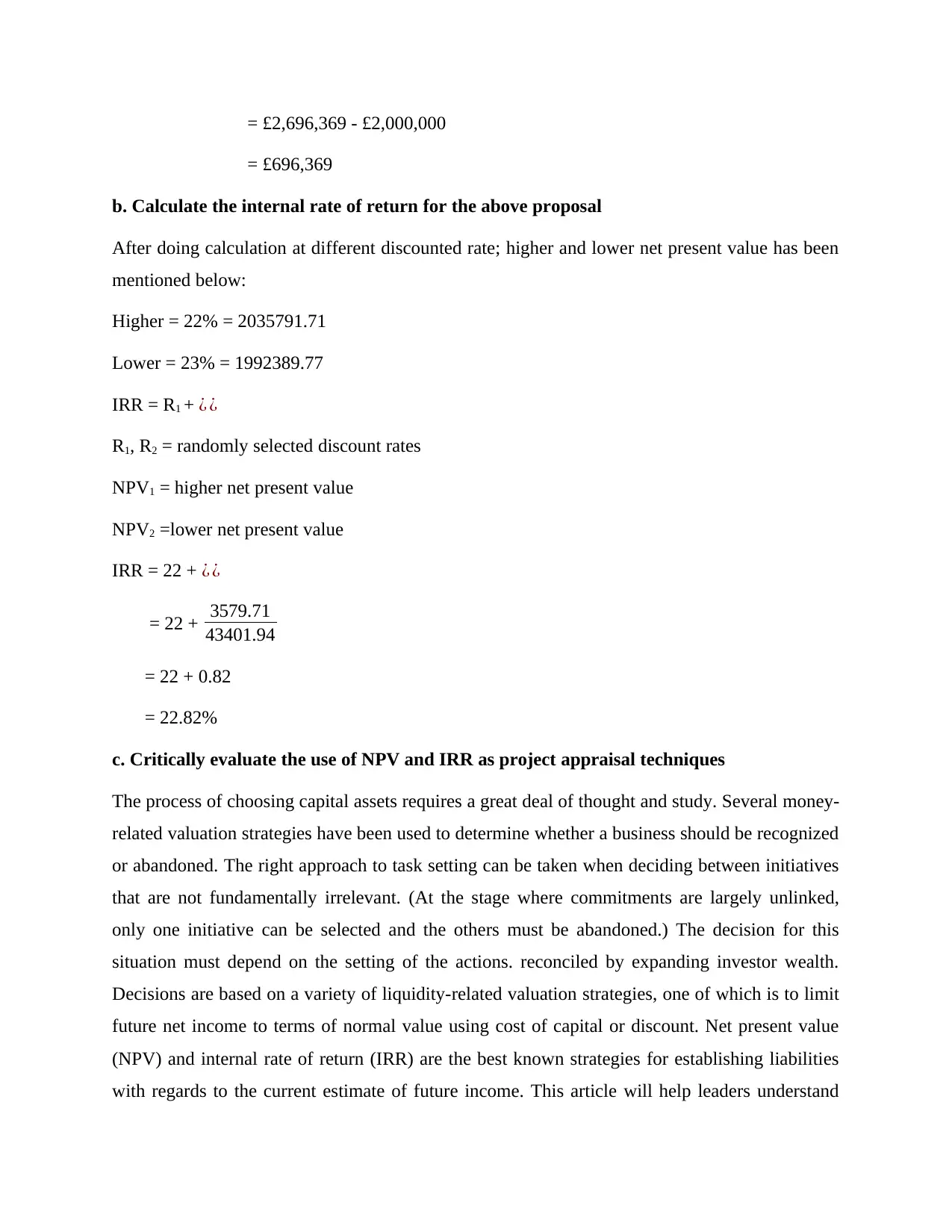
= £2,696,369 - £2,000,000
= £696,369
b. Calculate the internal rate of return for the above proposal
After doing calculation at different discounted rate; higher and lower net present value has been
mentioned below:
Higher = 22% = 2035791.71
Lower = 23% = 1992389.77
IRR = R1 + ¿ ¿
R1, R2 = randomly selected discount rates
NPV1 = higher net present value
NPV2 =lower net present value
IRR = 22 + ¿ ¿
= 22 + 3579.71
43401.94
= 22 + 0.82
= 22.82%
c. Critically evaluate the use of NPV and IRR as project appraisal techniques
The process of choosing capital assets requires a great deal of thought and study. Several money-
related valuation strategies have been used to determine whether a business should be recognized
or abandoned. The right approach to task setting can be taken when deciding between initiatives
that are not fundamentally irrelevant. (At the stage where commitments are largely unlinked,
only one initiative can be selected and the others must be abandoned.) The decision for this
situation must depend on the setting of the actions. reconciled by expanding investor wealth.
Decisions are based on a variety of liquidity-related valuation strategies, one of which is to limit
future net income to terms of normal value using cost of capital or discount. Net present value
(NPV) and internal rate of return (IRR) are the best known strategies for establishing liabilities
with regards to the current estimate of future income. This article will help leaders understand
= £696,369
b. Calculate the internal rate of return for the above proposal
After doing calculation at different discounted rate; higher and lower net present value has been
mentioned below:
Higher = 22% = 2035791.71
Lower = 23% = 1992389.77
IRR = R1 + ¿ ¿
R1, R2 = randomly selected discount rates
NPV1 = higher net present value
NPV2 =lower net present value
IRR = 22 + ¿ ¿
= 22 + 3579.71
43401.94
= 22 + 0.82
= 22.82%
c. Critically evaluate the use of NPV and IRR as project appraisal techniques
The process of choosing capital assets requires a great deal of thought and study. Several money-
related valuation strategies have been used to determine whether a business should be recognized
or abandoned. The right approach to task setting can be taken when deciding between initiatives
that are not fundamentally irrelevant. (At the stage where commitments are largely unlinked,
only one initiative can be selected and the others must be abandoned.) The decision for this
situation must depend on the setting of the actions. reconciled by expanding investor wealth.
Decisions are based on a variety of liquidity-related valuation strategies, one of which is to limit
future net income to terms of normal value using cost of capital or discount. Net present value
(NPV) and internal rate of return (IRR) are the best known strategies for establishing liabilities
with regards to the current estimate of future income. This article will help leaders understand
Paraphrase This Document
Need a fresh take? Get an instant paraphrase of this document with our AI Paraphraser

which of these two valuation methods - NPV or TIR - is best for evaluating fully independent
businesses.
Net present value method
The net present value (NPV) method is a mechanism for setting the business proposal using the
NPV, which is equal to the current estimate of net future income, limited to the When NPV is
zero, the income of the company is staggering enough to meet the required level of return for the
business and pay back the capital returned. At the level where the NPV is positive, there is
sufficient income to meet the operating obligation and return a return to investors The NPV is
also reported as a dollar estimate, which provides a positive indicator of investment productivity
and wealth development.
Internal Rate of Return Method
The Internal Rate of Return (IRR) method is “a mechanism for setting business advice using a
profit margin for profitability, determined by finding the rate of decline that compares with the
current estimate of future cash inflows by cost IRR is always reported as a rate. For a company
to qualify for the IRR mechanism, the depreciation rate must be higher than the capital
expenditure of the asset, also known as the impairment rate. IRR is not exactly the level of
restraint highlighting investor spending, while IRR is more pronounced than the barrier level
talking about profit margin, expanding investor wealth.
Decision:
The above calculation shows following results:
Net present value:
Net present value shows positive value which indicates that proposal is profitable and hence it
should be accepted; as NPV above 0 is acceptable.
IRR:
IRR of the proposal is greater than cost of equity (22.82% > 12%) and hence it is acceptable
Based on both the results; Lennon Plc is advised to accept the proposal.
businesses.
Net present value method
The net present value (NPV) method is a mechanism for setting the business proposal using the
NPV, which is equal to the current estimate of net future income, limited to the When NPV is
zero, the income of the company is staggering enough to meet the required level of return for the
business and pay back the capital returned. At the level where the NPV is positive, there is
sufficient income to meet the operating obligation and return a return to investors The NPV is
also reported as a dollar estimate, which provides a positive indicator of investment productivity
and wealth development.
Internal Rate of Return Method
The Internal Rate of Return (IRR) method is “a mechanism for setting business advice using a
profit margin for profitability, determined by finding the rate of decline that compares with the
current estimate of future cash inflows by cost IRR is always reported as a rate. For a company
to qualify for the IRR mechanism, the depreciation rate must be higher than the capital
expenditure of the asset, also known as the impairment rate. IRR is not exactly the level of
restraint highlighting investor spending, while IRR is more pronounced than the barrier level
talking about profit margin, expanding investor wealth.
Decision:
The above calculation shows following results:
Net present value:
Net present value shows positive value which indicates that proposal is profitable and hence it
should be accepted; as NPV above 0 is acceptable.
IRR:
IRR of the proposal is greater than cost of equity (22.82% > 12%) and hence it is acceptable
Based on both the results; Lennon Plc is advised to accept the proposal.
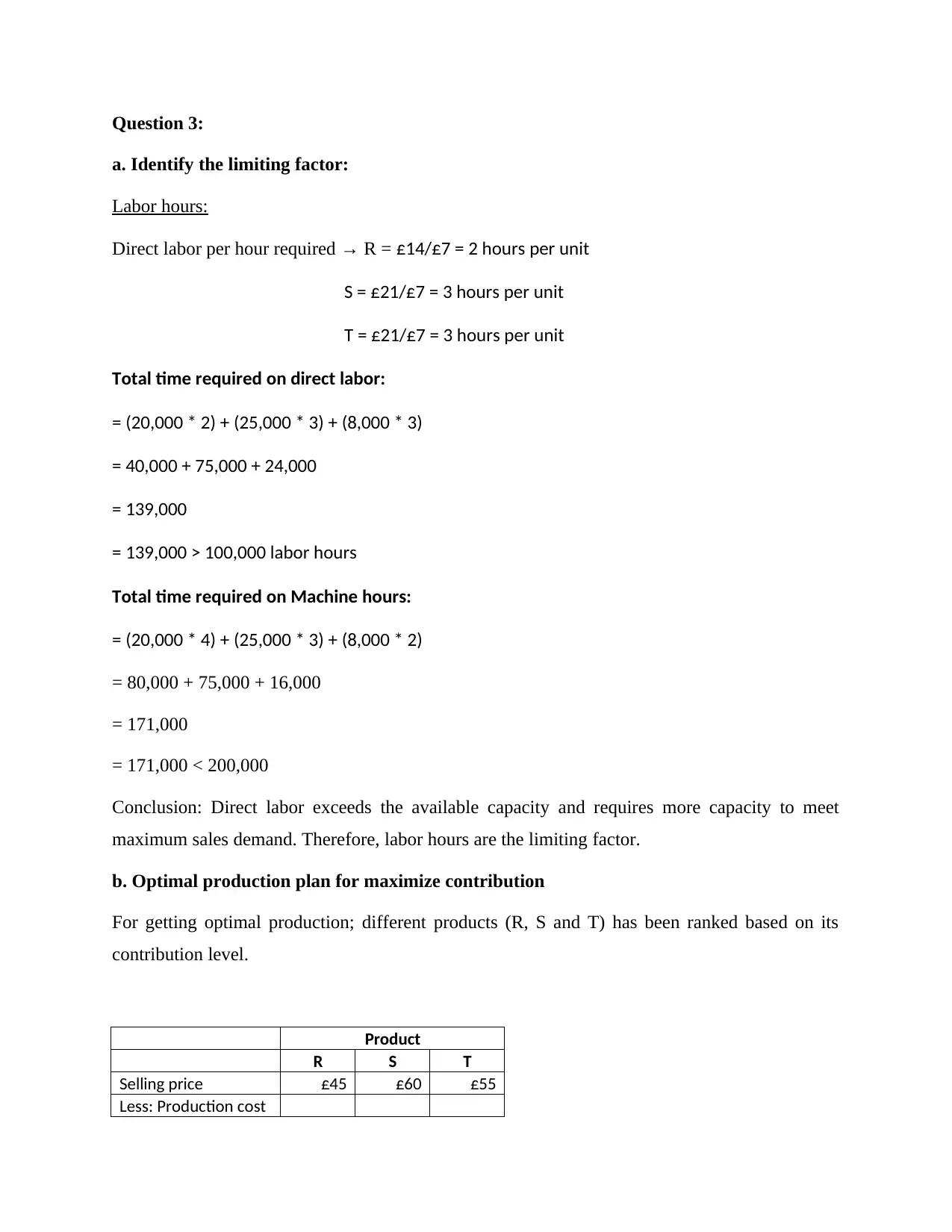
Question 3:
a. Identify the limiting factor:
Labor hours:
Direct labor per hour required → R = £14/£7 = 2 hours per unit
S = £21/£7 = 3 hours per unit
T = £21/£7 = 3 hours per unit
Total time required on direct labor:
= (20,000 * 2) + (25,000 * 3) + (8,000 * 3)
= 40,000 + 75,000 + 24,000
= 139,000
= 139,000 > 100,000 labor hours
Total time required on Machine hours:
= (20,000 * 4) + (25,000 * 3) + (8,000 * 2)
= 80,000 + 75,000 + 16,000
= 171,000
= 171,000 < 200,000
Conclusion: Direct labor exceeds the available capacity and requires more capacity to meet
maximum sales demand. Therefore, labor hours are the limiting factor.
b. Optimal production plan for maximize contribution
For getting optimal production; different products (R, S and T) has been ranked based on its
contribution level.
Product
R S T
Selling price £45 £60 £55
Less: Production cost
a. Identify the limiting factor:
Labor hours:
Direct labor per hour required → R = £14/£7 = 2 hours per unit
S = £21/£7 = 3 hours per unit
T = £21/£7 = 3 hours per unit
Total time required on direct labor:
= (20,000 * 2) + (25,000 * 3) + (8,000 * 3)
= 40,000 + 75,000 + 24,000
= 139,000
= 139,000 > 100,000 labor hours
Total time required on Machine hours:
= (20,000 * 4) + (25,000 * 3) + (8,000 * 2)
= 80,000 + 75,000 + 16,000
= 171,000
= 171,000 < 200,000
Conclusion: Direct labor exceeds the available capacity and requires more capacity to meet
maximum sales demand. Therefore, labor hours are the limiting factor.
b. Optimal production plan for maximize contribution
For getting optimal production; different products (R, S and T) has been ranked based on its
contribution level.
Product
R S T
Selling price £45 £60 £55
Less: Production cost
⊘ This is a preview!⊘
Do you want full access?
Subscribe today to unlock all pages.

Trusted by 1+ million students worldwide
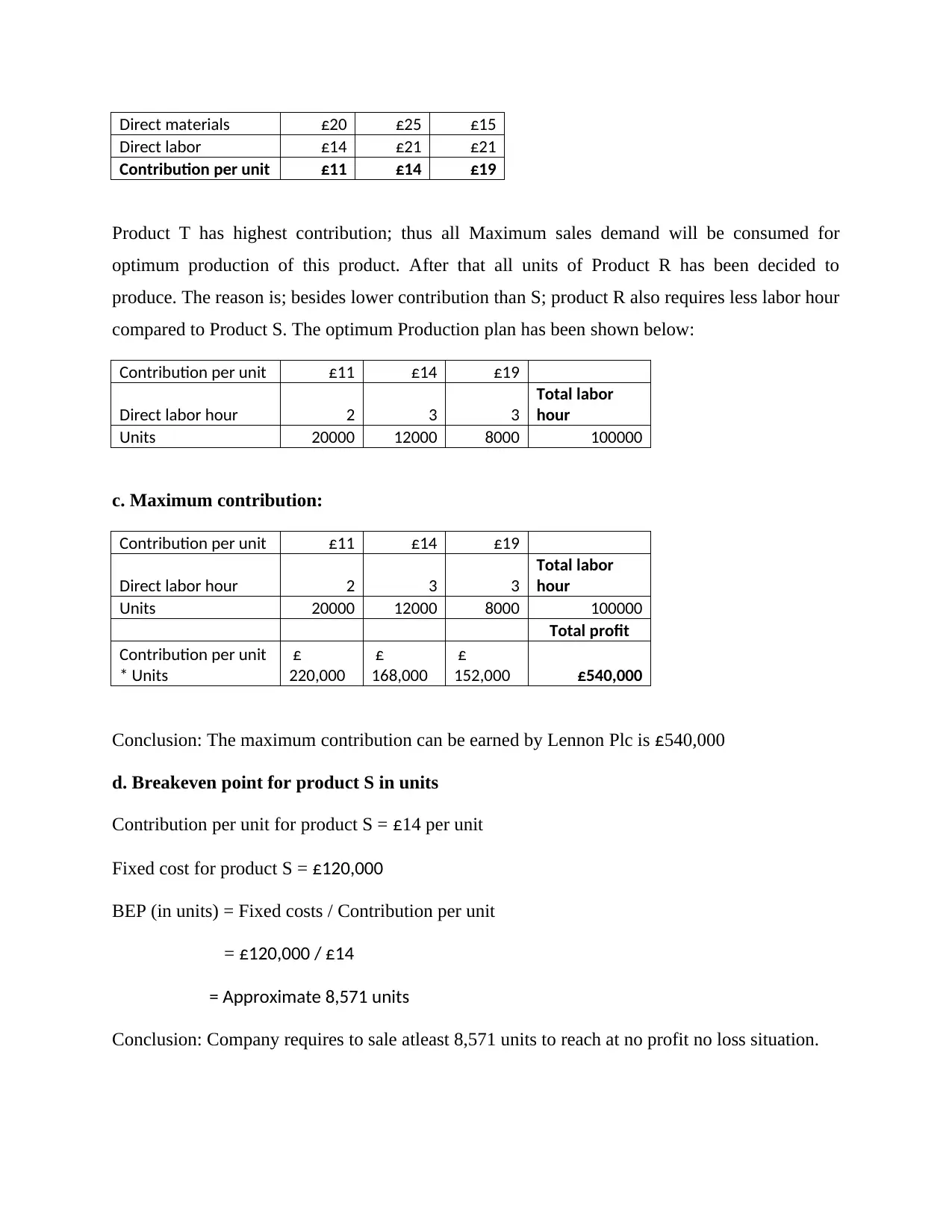
Direct materials £20 £25 £15
Direct labor £14 £21 £21
Contribution per unit £11 £14 £19
Product T has highest contribution; thus all Maximum sales demand will be consumed for
optimum production of this product. After that all units of Product R has been decided to
produce. The reason is; besides lower contribution than S; product R also requires less labor hour
compared to Product S. The optimum Production plan has been shown below:
Contribution per unit £11 £14 £19
Direct labor hour 2 3 3
Total labor
hour
Units 20000 12000 8000 100000
c. Maximum contribution:
Contribution per unit £11 £14 £19
Direct labor hour 2 3 3
Total labor
hour
Units 20000 12000 8000 100000
Total profit
Contribution per unit
* Units
£
220,000
£
168,000
£
152,000 £540,000
Conclusion: The maximum contribution can be earned by Lennon Plc is £540,000
d. Breakeven point for product S in units
Contribution per unit for product S = £14 per unit
Fixed cost for product S = £120,000
BEP (in units) = Fixed costs / Contribution per unit
= £120,000 / £14
= Approximate 8,571 units
Conclusion: Company requires to sale atleast 8,571 units to reach at no profit no loss situation.
Direct labor £14 £21 £21
Contribution per unit £11 £14 £19
Product T has highest contribution; thus all Maximum sales demand will be consumed for
optimum production of this product. After that all units of Product R has been decided to
produce. The reason is; besides lower contribution than S; product R also requires less labor hour
compared to Product S. The optimum Production plan has been shown below:
Contribution per unit £11 £14 £19
Direct labor hour 2 3 3
Total labor
hour
Units 20000 12000 8000 100000
c. Maximum contribution:
Contribution per unit £11 £14 £19
Direct labor hour 2 3 3
Total labor
hour
Units 20000 12000 8000 100000
Total profit
Contribution per unit
* Units
£
220,000
£
168,000
£
152,000 £540,000
Conclusion: The maximum contribution can be earned by Lennon Plc is £540,000
d. Breakeven point for product S in units
Contribution per unit for product S = £14 per unit
Fixed cost for product S = £120,000
BEP (in units) = Fixed costs / Contribution per unit
= £120,000 / £14
= Approximate 8,571 units
Conclusion: Company requires to sale atleast 8,571 units to reach at no profit no loss situation.
1 out of 7
Related Documents
Your All-in-One AI-Powered Toolkit for Academic Success.
+13062052269
info@desklib.com
Available 24*7 on WhatsApp / Email
![[object Object]](/_next/static/media/star-bottom.7253800d.svg)
Unlock your academic potential
Copyright © 2020–2025 A2Z Services. All Rights Reserved. Developed and managed by ZUCOL.





